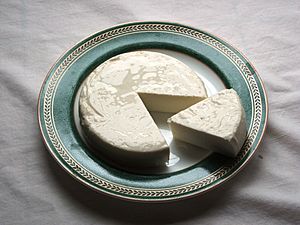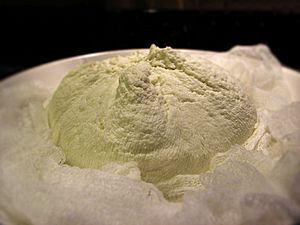Queso blanco facts for kids
Quick facts for kids Queso blanco |
|
|---|---|

A plate of Queso fresco
|
|
| Region | Latin America |
| Source of milk | Cows |
| Named after | Lua error in Module:Wikidata at line 70: attempt to index field 'wikibase' (a nil value). |
Queso blanco means "white cheese" in Spanish. It's a name for many different kinds of cheeses. The main thing they all share is their white color! What "queso blanco" means exactly can change depending on where you are in the world.
Contents
Making White Cheese
Making queso blanco is quite simple. It doesn't need special ingredients like rennet (which helps milk curdle) or special bacteria. This makes it one of the easiest cheeses to create at home.
How It's Made
To make this cheese, you heat fresh milk almost to boiling. Then, you add something acidic, like vinegar. This makes the milk separate into solid bits called "curds" and a watery liquid called "whey."
After the curds form, they are drained using a special cloth called cheesecloth. The curds are often hung in this cloth for a few hours. This is why these cheeses are sometimes called "bag cheeses."
Freshness Matters
Many families in Mexico make their own queso blanco. They often prepare it in the afternoon to be ready for dinner. Since it's a fresh cheese, it needs to be kept cold or eaten right away once the whey is drained.
Ways to Enjoy Queso Blanco
Queso blanco and a similar cheese called queso fresco are very versatile. You can eat them plain, or add them to many different dishes.
Popular Uses
These cheeses are often crumbled over spicy Mexican foods. Think of dishes like enchiladas and empanadas. They also taste great sprinkled on soups or salads.
Some types of queso blanco melt well. These are perfect for making cheesy quesadillas. In places like the United States, it's even used to make cheesecake!
Peruvian Sauces
In Peruvian cuisine, queso fresco is mixed with spices to make a tasty cold sauce. This sauce is often served over boiled potatoes. Two famous dishes are papa a la Huancaína and ocopa.
White Cheese Around the World
The name "queso blanco" is used in many countries. However, the exact type of cheese can be different in each place.
Mexico's White Cheeses
In Mexican cuisine, traditional queso blanco is made from cow's milk. Queso fresco can be made from a mix of cow's and goat's milk. Some Mexican white cheeses, like Oaxaca cheese, melt nicely when heated. Most others just get soft.
If more water is pressed out of the cheese, it becomes known as queso seco. Sometimes, it's even made by pressing the liquid out of cottage cheese.
Brazil's Queijo Branco
In Brazil, this cheese is called queijo branco. It's a popular fresh cheese there.
Dominican Republic and Nicaragua
In the Dominican Republic cuisine and Nicaraguan cuisine, queso blanco is a firm, salty cheese. It's often used for frying and is known as Queso Frito.
Philippines' Kesong Puti
In the Philippines, a similar cheese is called kesong puti. This cheese is special because it's made from water buffalo's milk.
Portugal's Queijo Fresco
In Portuguese cuisine, queijo fresco is a very popular mild, soft, and creamy white cheese. It's not aged at all. In the Azores, queijo fresco is often served with a fresh pepper sauce called pimenta de terra.
Puerto Rico's Queso Boricua
In Puerto Rican cuisine, queso blanco is a firm cheese. It's often fried and paired with sweet papaya syrup. It's also known as queso Boricua or queso frito. While still liked, new, high-quality cheeses are becoming available on the island.
Venezuela's Diverse White Cheeses
Venezuelan cuisine has many different kinds of white cheeses. They vary a lot in how they feel and taste. They are usually named after the region where they come from.
Cheeses Like Queso Blanco
Many other cheeses around the world are similar to queso blanco. They might be called different names but share some common traits.
- halloumi
- Indian paneer
- farmer cheese
- pot cheese
- quark (also known as tvorog) from Central and Eastern Europe


